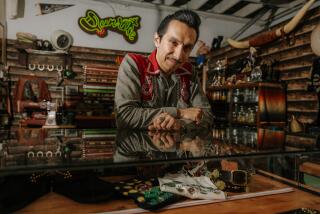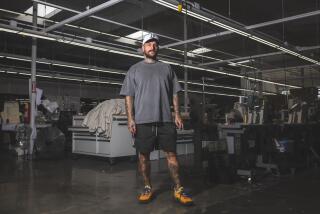Driven: Customizing a Porsche 911 into a work of art
“It’s crazy, isn’t it?” says Drew Coblitz with a laugh. The 31-year-old Philadelphia-based luxury expert and entrepreneur is the owner of Singer Vehicle Design’s latest work of art, a gloriously up-leveled and optimized 1990 Porsche 911. I’m laughing too, but mostly because of the visceral reactions his meticulously specced, inky-blue-black car is provoking in me.
For a few high-speed moments I’m the lucky one in his driver’s seat, a work of woven-leather art in its own right. With the hand-carved ebony wood shifter knob in my right hand (pretty much every detail, from the car’s tuning down to literal nuts and bolts, is customized by Singer for each client) and my feet dancing across all three pedals in the footwell below, I’m in internal combustion heaven. Coblitz’s one-off is a formidable yet nimble sports car with a howling, high-revving soul, hellbent on devouring the curvaceous canyon road we’re on as though it might never see another.
For the record:
10:34 a.m. Nov. 16, 2019In an earlier version of this article, an inaccurately rendered quote by Rob Dickinson suggested that hip hop-mogul Jay-Z had been interviewed on TV while driving in one of Dickinson’s customized vehicles. Dickinson was referring to himself, not Jay-Z, in the quote.
Singer Vehicle Design is a skunkworks hidden away in Sun Valley that optimizes Porsche 911s from 1989 to 1994, the era that purists consider the pinnacle of the German manufacturer’s air-cooled engineering. These are not merely restored sports cars, though, these are masterpieces of next-gen engineering, materials science and haute couture-level interiors. Think of them as the automotive equivalent of Faberge eggs on steroids. Or to personify it all, imagine Sean Connery’s 007 crossed with Charlize Theron and blended with a dash of Joaquin Phoenix’s Joker: sexy, strong, audacious — and ultimately brilliant.
The man behind Singer is Rob Dickinson, a wickedly witty Brit and former songwriter and lead singer of the ’90s rock band Catherine Wheel. Since the first 911 he spotted on the road in 1970 as a 5-year-old, he’s been smitten with them. Finally, after a stint designing at Lotus Cars before focusing on his music and a world tour with his band ahead of their breakup in 2000 — with lots of tinkering on his own cars in between — Dickinson landed in Los Angeles to buy a 1969 911 E and fell in love with its rich car culture. By 2009, he started Singer. “We’re taking a legend that Porsche put to one side 20 years ago to pursue other, forward-looking cars,” says Dickinson. “We have the benefit of hindsight, and I’d like to think we are shining quite a bright light on Porsche’s heritage.”
So what does an “insane” Singer detail look like? On every production car, even Mercedes and Ferrari models, there’s a gap between each panel — the door and the rear fender, for example — and something called flush. Run your hand over the gap between panels and if one is higher or lower, the flush is off. “If you take a caliper and measure our gaps and flush, they will be perfect on every car,” says Mazen Fawaz, Singer managing director, tech entrepreneur and Formula One legend Jenson Button’s teammate for this year’s Baja 1000. “It sounds silly, but you have one shot at getting those perfect. If they aren’t, a car doesn’t leave our hands.”
This isn’t your average Christmas tree.
Every car that passes through a Singer transformation requires a minimum of 4,000 human hours to transform. Customers can spend up to a year choosing the right bespoke combinations of leathers and paint colors, trim and multiple transmission and suspension parameters. There are 500 leather colors, 13 leather types to sort through (each car uses seven hides) and limitless paint options. The leather is hand-stitched in the company’s Orange County-based interiors studio, overseen by Andy Harrison, who has masterminded the insides of important machines such as the McLaren F1, Formula 1 cars, Lotuses, Jaguar super cars, the DeLorean and even SpaceX rockets. “One owner showed us a photo of a sunset,” says Harrison. “We ended up using nearly a dozen different colors in the weave for the seats — a weave that is only achievable by a few companies in the world.”
Coblitz, one of Singer’s youngest customers, went into the commissioning of his car with a specific vision too. “I wanted to do a murdered-out Singer because people very often go for the very pretty, very bright colors or the heritage colors, which are awesome,” he says. “But I wanted something more modern and edgy.”
That led to months of testing dozens of exterior paint solutions. Through the process, Coblitz realized that black, even complex versions, was too pedestrian. He finally landed on a shade of dark blue that looks black in certain light conditions, while others highlight the depth of the navy. He also worked with the Singer team to change all the brightwork on the car —the metal trim — to dark nickel, another nod to his desired look, and one no other customer had requested. He even came up with a name for the car that Singer turned into a dark nickel-plated aluminum alloy nameplate on the rear deck lid: SINQNON, a reference to the Latin for “essential to existence,” sine qua non. “I don’t usually name my cars,” Coblitz says. “But it was my take on Rob’s ‘everything is important’ mantra.”
Welcome to our comprehensive gift guide for the 2019 holiday season. This list encompasses the most popular and best gifts for everyone in your life.
He’s referring to a now-hallowed moment early on at the Singer headquarters when late one evening Dickinson, frustrated by others not grasping the depth of his desire for perfection, grabbed a can of black spray paint and memorialized those words on the original shop wall.
It’s time, though, to rip the bandage off and talk price. A 911 reimagined by Singer will set you back a minimum of $475,000 for a classic coupe, not including the “donor” car that each customer must provide. In today’s collector-car market, that base vehicle can cost on average from $48,000 and up. (Singer Vehicle Design isn’t a dealer, but the company can offer some direction.) “There’s a high cost to what we do but everything we do doesn’t have to be expensive,” Dickinson says, “but it does have to be brilliant; I only want to build cars that make my mouth go dry I want them so much.”
That may not sound like a winning business model — the road is littered with failed attempts to restore, modify, hot rod or otherwise tweak famous models — but against all odds, Singer is celebrating its 10th anniversary this year and steadily growing. The company has delivered 130 cars to date and has as many on order.
Dickinson’s vision, while laser-focused on making brilliant machines, also has a restless side. Last year the company debuted an ultra-rare, limited-edition version referred to as the DLS. It was co-created with the engineering arm of the U.K.-based Williams Formula 1 team, Michelin and other partners. Only 75 will be made, with a base price of $1.8 million.
The company’s design standards have branched out beyond automotive. In 2017, Dickinson collaborated with Italian watch designer Marco Borraccino, former head designer at Panerai. The resulting company, Singer Reimagined, is creating high-end watches that pay homage to the iconic sports models of the 1960s and 1970s. They are as authentic and expensive as Singer’s cars: up to $85,000 for what is a unique solution in the watch world, just as Singer’s cars reinvent in their own realm.
And while he won’t comment on future plans, Dickinson acknowledges that he’s only just begun to apply his aesthetic to objects he deeply desires. So stay tuned.
I asked him when, in the flurry of the last 10 years’ worth of hard labor, occasional cash flow worries and scaling a custom-car business into a limited-production concern, he picked his head up and realized his success. “The first time, it was walking into a Starbucks in Northern England and being recognized — not for my music but because they’d seen all of our car videos on YouTube and were die-hard fans,” Dickinson says. “The second moment was when my son saw a journalist interviewing me while driving together in one of our cars. He turned from the TV to look at me with an awe and respect I’d never seen before.”
More to Read
Sign up for The Wild
We’ll help you find the best places to hike, bike and run, as well as the perfect silent spots for meditation and yoga.
You may occasionally receive promotional content from the Los Angeles Times.











